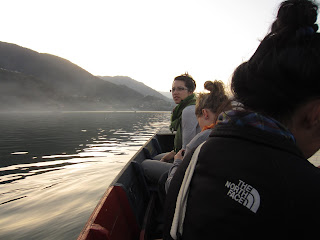We visited a TB hospital last week as well as the oldest hospital in Kathmandu (120 years old!). We had an extensive tour of the waste management system in the hospital (a bit random, but it gave us exposure to the wards and I think the WM people were the only ones not on lunch break at the time we visited. Hehe).
There were lots of creative ways to manage the waste and an extensive recycling system--very refreshing and much more thoughtful than our own hospitals. It was also good to see that needles weren't just getting dumped somewhere!
My favorite thing we've done so far was the visits to the health outposts! Aarti, John, Katie and I went to Bolde, a 2.5 hour jeep ride and a 45 minute hike into the beautiful Nepali hills! The road was a bit treacherous, hugging the hills and one time we left the jeep to move rocks off the road! We stopped on the hiking part to visit with some of the locals and got to meet two women and a local medical shaman, who shared his expertise in prenatal care--using a method consisting of forming nine boxes that included numbers that added to fifteen no matter which direction you worked your math magic! If he did that and created an amulet for a woman, she would deliver, he said. He also said he has been referring deliveries to the hospital for the last 15 years, so perhaps that's for the best :)
The women were also very interesting to speak with. They gave us a run down of their days, told us the men usually drink tea while they wake up, make food for the livestock, feed the family, work in the fields, and re paint their house (a daily process apparently!). This reminded me a lot of womens' roles in Mali, while the men make tea. Some things are hard to change...
We got to the health outpost after a beautiful hike. My favorite part aside from the people were the people trees! I have no idea what the actual taxonomy is, but these are huge old trees that come in pairs of male and female and they are somewhat revered. They look completely amazing. And, did I mention they are called people trees? Fantastic.
We also passed a very nice little Buddhist stupa as people in this area are Tamang, who are Buddhist. Cultural reminders!
I already wrote a bit about the health outpost visit--with the patient education session on cervical cancer and screening. It was so remarkable and I have a very high level of respect for the doctor we worked with. It is so rare for someone from this country to stay as a physician, and particularly rare for someone to want to work in rural areas with and for a remote community like this. She trained in Austria, returning to Nepal every few months, always ensuring that what she learned would continue to have relevance to her work in Nepal. There are two Norweigian medical students working at the outpost as well, Havar and Kari (spelling?), doing research on iodine deficiency and cervical cancer, respectively. Aarti thought people were referring to Harvard research, not Havar's research, so now I like to think of Havar as Harvard. :) Fun times with foreign languages!
Niki and Katherine had a different experience at their health outpost and saw a lot of patients over their day. They also said they had a great experience!
Over the weekend, we visited a stupa (hindu shrine) called Namo Buddha, where a man sacrificed himself to a mother tiger and her cubs and afterward got sucked up to heaven/nirvana. It was such a beautiful hike! There were beautiful prayer flags everywhere and you could hear the drums and chants from the monks. We walked to another town afterward and it was an amazing look at the countryside. There were tons of orange orchards that smelled completely magically orangey and I definitely romanticized the somewhat idyllic scenes of women working in their terraced fields (didn't see any men working though! A lot of men leave the country to outsource their work to India due to tough exonomic circumstances in Nepal, and send money home. This is pretty complicated but seems like a tough deal. They are absent a lot and oftentimes gamble or pick up STIs in India that come back to Nepal with them).
Sundays are work days in Nepal, so we had a day of orthopedics yesterday (focus on extrapulmonary TB--TB bone infections!) and today picked up some pediatric lectures. I've been super impressed with the curriculum they're piloting with our group. I must admit I had low expectations of things working out, and have been pleasantly surprised! I expected to be fighting for myself a lot to get good learning experiences, but it feels as though things are just being dropped into our laps! It's really making me happy and excited to learn more on my own. We've been doing additional reading in some of the tropical medicine books here and it's pretty amazing to be seeing what you're learning about so consistently.
We also just got Internet working in our guest house?!!!! So that's pretty awesome! Takes one challenge out of emailing and blogging, leaving us more or less only dependent on the electricity, which comes and goes.
I have many more photos that I'll try and add to this post as time allows--hospital learning, hiking, the beautiful countryside, more from the health outpost visit! And fun times at the KUIC (our guest house).
Til then, love and missing!
--Elisabeth
 |
| A woman we spoke with on the hike up to Bolde, with a baby goat! Born last night :) BABY ANIMALS!! |
















































